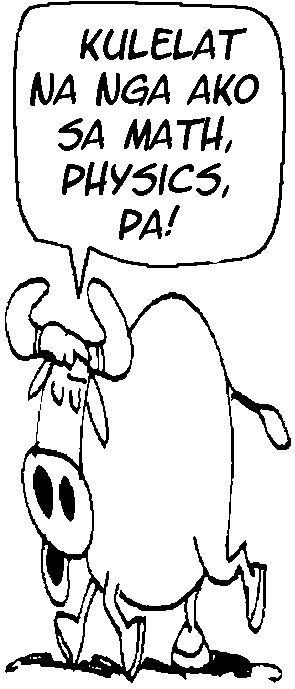Using network maps, a physics professor and his students at the University of the Philippines (UP) in Diliman showed the connections between nongovernment organizations (NGOs) and lawmakers allegedly involved in the pork barrel scam.
“On the average, a legislator distributes his PDAF (Priority Development Assistance Fund) to 21.38 (or 21) NGOs,” said the study prepared by Giovanni Tapang (associate professor at the UP National Institute of Physics) and his students Pamela Anne Pasion and Gabriel Dominik Sison.
The study found that “NGOs typically receive allocations from 7.68 (or 7) different legislators on the average.”
It was based on the Commission on Audit (COA) special report on the 2007-2009 PDAF releases.
Network analysis, which involves computer science and mathematics, has long been used for sociology, telecommunications and even state intelligence activities.
Some of its practical applications include mapping crime rings or terrorist networks.
In a Facebook post, Tapang said the initial study showed that “both NGOs and congressmen have shared communities” and that some of them give PDAF to and get PDAF from multiple sources, making them “hubs,” or heavily linked objects of the networks.
Bigger, smaller networks
The visual network also showed six “communities” of lawmakers who tended to give to the same set of NGOs.
A closer look at the data showed Senators Juan Ponce Enrile, Jinggoy Estrada, Ramon Revilla Jr. and Gregorio Honasan in one of the bigger networks.
Former Sen. Edgardo Angara, former Negros Occidental Rep. Ignacio Arroyo Jr. and Sen. Loren Legarda can be found in a smaller one.
“We can rank the legislators based on the number of ‘partners’ they have, of which ex-Bohol Rep. Adam Relson Jala tops the list. This is reflected in the high degree of his connections.

Influence and connections in the network were also measured through “betweenness centrality.”
Central to network
Using such a technique, the top 10 legislators “central” to the network were the following:
1. Sen. Juan Ponce Enrile
2. Former Davao del Norte Rep. Arrel Olano
3. Former Negros Occidental Rep. Ignacio Arroyo Jr. (died in 2012)
4. Former Bohol Rep. Adam Relson Jala
5. Surigao del Norte Rep. Francisco Matugas
6. Former Sen. Edgardo Angara
7. A-Teacher Rep. Mariano Piamonte
8. Former Cibac Rep. Emmanuel Joel Villanueva
9. Former Benguet Rep. Samuel Dangwa
10. Former Davao del Sur Rep. Marc Douglas Cagas IV
The NGOs were clustered in five communities, according to the study.
Using the group’s visual data, Inquirer.net found in one network organizations linked to Janet Lim-Napoles, the alleged mastermind of the P10-billion pork barrel scam.
These were the eight NGOs mentioned by COA chair Gracia Pulido-Tan at the Aug. 29 Senate hearing on the pork barrel scam:
— Agri and Economic Program for Farmers Foundation Inc. (AEPFFI)
— Agricultura Para sa Magbubukid Foundation (APMFI)
— Countrywide Agri and Rural Economic Development (Cared) Foundation
— Masaganang Ani Para sa Magsasaka Foundation, Inc (Mamfi)
— People’s Organization for Progress and Development Foundation (POPDFI)
— Philippine Agri and Social Development Foundation Inc.
— Philippine Social Development Foundation Inc. (PSDFI)
— Social Development Program for Farmers Foundation Inc. (SDPFFI)
The paper said Mamfi topped the list of important organizations in the network, followed by Cared and SDPFF.
Betweenness
The “betweenness centrality” technique applied to NGOs would also reveal the following NGOs with most influence and connections:
— Kagandahan ng Kapaligiran Foundation Inc. (KKFI)
— Kabuhayan at Kalusugan Alay sa Masa Foundation Inc. (Kkamfi)
— Dr. Rodolfo A. Ignacio Sr. Foundation Inc. (Draisfi)
— Farmerbusiness Development Corp. (FDC)
— Aaron Foundation Philippines Inc. (AFPI)
— Masaganang Ani Para sa Magsasaka Foundation Inc. (Mamfi)
— Pangkabuhayan Foundation (Pang-FI)
— Kaagapay Magpakailanman Foundation Inc. (KMFI)
— Ito Na Movement Foundation Inc. (Ito Na Mi)
— Hand-Made Living Foundation Inc. (HMLFI)
Transactions
Tapang said the preliminary study revealed connections based only on the number and similarities of transactions.
“These are just a sample of the things we can do with the network representation of the PDAF releases. Deeper knowledge about Congress and the interlocking directorships of the NGOs would also be extremely helpful in further analysis. This will be done in a future work,” the paper said.
“Nevertheless, these tools allow the average Filipino to glean information readily as opposed to tables and documents, helping them better participate in the process of democracy,” it added.
Tapang said the next study would tackle the amount of PDAF that changed hands between lawmakers and NGOs but connections alone and the frequency of transactions already showed interesting relations.
Using the group’s visual data, INQUIRER.net found Napoles-linked NGOs grouped in one community.
Originally posted: 1:29 pm | Tuesday, September 10th, 2013